|
|
6th November 2015 - Action Duchenne International Conference 2015
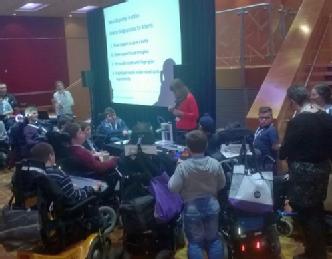 |
|
Project Officer, Diane Burton gave a presentation entitled "How 3D printing can empower assistive technology users". The presentation discussed the objectives and successess of this Assistive Technology project; looked at some of the latest developments in 3D printing which could be relevant to AT users; and went on to discuss how people could get involved in CAD and 3D printing.
During the afternoon, Diane ran a workshop showing the design process for 4 of the products designed and 3D printed during the project - 2 types of straw support and 2 types of holder for a pot noodle.
The tutorial resources for making these products can be found at  www.warwick.ac.uk/schools3dprinting www.warwick.ac.uk/schools3dprinting
|
|
1st October 2014 - Assistive Tech Project features at TCT 3D Printing Show at the NEC, Birmingham
|
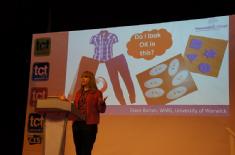 |
|
Project Officer, Diane Burton, was invited to speak about the project at this International 3D Printing Show. A number of the products designed and produced during the project were featured on a display for the duration of the show
Follow this link to see the presentation.
|
|
4th June 2014 - Students attend Project Showcase event at University of Warwick
|
|
Students from Hereward College who have taken part in the Assistive Technology Project spent the day at the University of Warwick showcasing their work on the project. There were displays about what they had learned and achieved and examples of the assistive tech products they have developed. Hereward students did a great job of telling guests about the products they had created. Hereward students Joel Morrison and Sally Walton demonstrated the use of the 3D CAD software used on the project and invited guests to try it out. The Cubex Trio 3D printer used on the project was set up and running for guests to see and some of the students explained how the printer works.
|
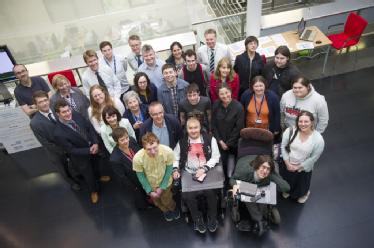 |
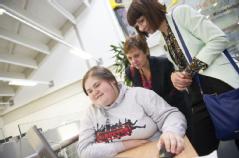 |
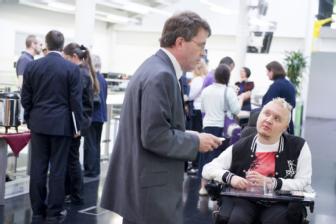 |
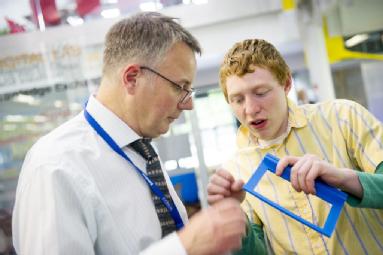 |
|
Some of the products designed and produced by the Hereward 3D printing group
|
Stand for a communication aid
Below left is a communication aid used to help a student with severely impaired speech to hold a conversation. The device has a simple U-shaped metal bracket on the back as shown. The problem is that it tends to slide away from the user when the device buttons are pressed or when it is knocked accidentally by the user as can easily happen.The group designed a simple 3D printed stand which the metal bracket clips into – as seen in the picture to the right. The stand stabilises the communication aid making it easier to use and holds it at the correct angle for the student. With 3D printing, it is quick and simple to make adjustments to the design to suit the user, e.g. to enable the communication aid to sit at a slightly different angle or the user may simply prefer a different colour stand. For extra stability some double-sided velcro or simply a couple of rubber pads can be placed on the bottom of the stand before it is put onto the wheelchair tray.
|
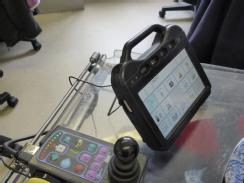
|
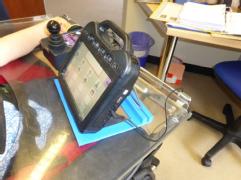 |
Holder for an environmental control
Wheelchair users often have an environmental remote control which can be programmed to do tasks such as open doors, open curtains, switch lights on and off, etc. The control tends to sits on the wheelchair tray and users have to pick it up and get it at the correct angle to use - it must point to the infra red sensor which is part of the control system and is generally located above the door.These controls often slip off the wheelchair tray onto the floor and get damaged - they are very expensive! We designed a holder which the control fits snuggly into. It places the control at the correct angle and the base of the holder can simply be velcroed to the wheelchair tray. |
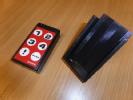
|
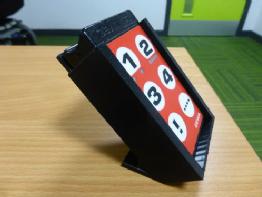 |
A straw support for use with a range of bottle sizes
Just before Christmas, Hereward student Ollie Baskaran made the important step of using his new-found skills to think of a product idea which he could design and 3D print to solve a problem he encounters. Ollie’s condition means he has to drink from a straw, but the straw bobs around in the bottle and often falls out. With some help from student tutor Russell, Ollie designed a straw support which fits neatly in the top of a bottle. The design has a series of rings to allow the straw support to fit a variety of bottles. |
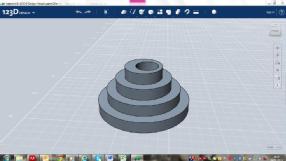 |
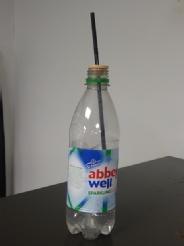 |
Straw supports for different types of drinking glass
|
| Ollie was so pleased with his new creation that he put a post on Facebook to tell people about his new 3D printed creation. This led to requests from other students at Hereward for straw supports to be used with different types of glasses. Below are the 2 products the group designed and printed - the one on the left works with a straight-sided glass and the longer one on the right works with a curved sided glass. |
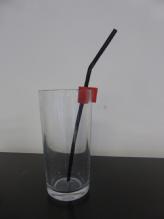 |
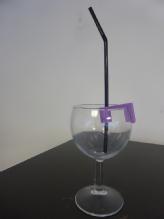 |
|
November 2013 – Hereward students make excellent progress learning to use 3D CAD
Hereward students involved in the project were introduced to 123D Design 3D CAD software in October and have made very good progress using the range of screenshot and screencast tutorials compiled for this project. Initially they learned to use the software to draw a variety of small items such as a badge with their name on and a keyring, a safe handle, a security cardholder. These items were 3D printed and the students were able to take them home to show family and friends.
|
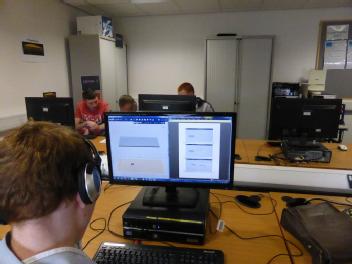 |
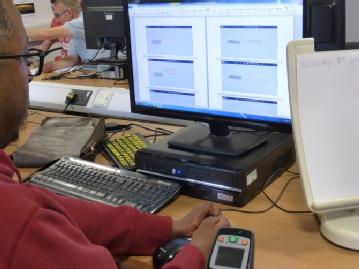 |
Hereward Students using tutorials to learn to use 123D Design 3D CAD software
|
| As the students’ skills increased, they drew their first assistive technology product for a fellow Hereward student. This was a new bespoke handle for a mini safe. The safe is used for storing medication by a Hereward student who has limited hand function, so is unable to use the small dial on the safe and needs a carer to operate the safe. A large handle he could just tap up and down was required. A tutorial was produced to enable the students to see the process of taking the measurements needed for the finished item, then drawing the design in the CAD software ready to be 3D printed. The design was 3D printed and has since been in daily use by the student. |
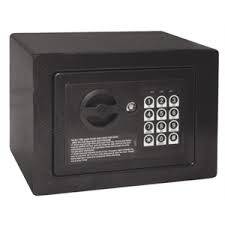 |
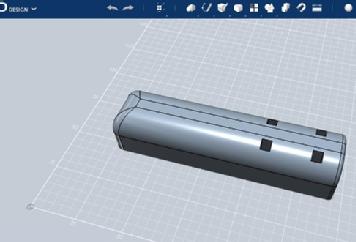 |
| Mini safe with unsuitable dial handle |
CAD drawing of safe handle completed by Hereward students |
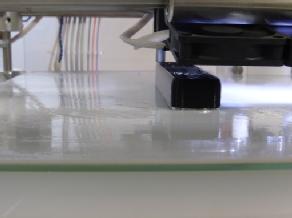 |
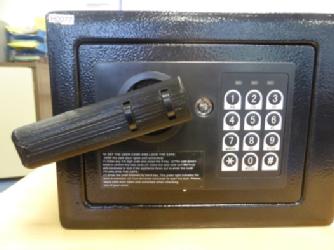 |
| New handle being 3D printed |
The finished safe with new handle attached |
Friday 4th October 2013
Professor Les Ebdon, Director of the Office for Fair Access visits Hereward College
Professor Ebdon toured the college and chatted to staff and students about this partnership project with Warwick University
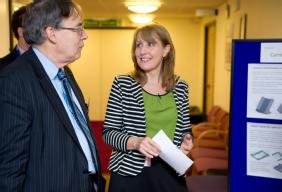 |
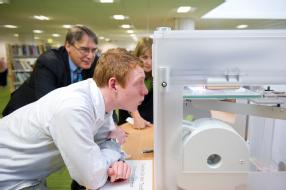 |
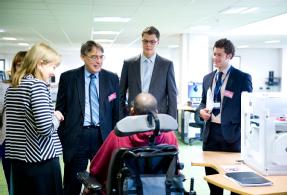 |
Project Officer Diane Burton discussing the
project aims and progress with Professor
Ebdon |
Professor Ebdon and one of the students
watching the Hereward College 3D printer
in action |
Professor Ebdon chatting to Hereward student
Chris Samuels about how he hopes the project
will help him |
Wednesday 25th September 2013
Project Launch Event for Hereward College Students held at Warwick University
Fourteen students taking part in the project spent the day at the University and were hosted by staff and student tutors from WMG and Computer Science. They enjoyed a tour of WMG, including the 3D Powerwall, Rescue Robot, Formula Student car and they saw the excellent 3D printing technologies available at the University. They spent the afternoon working with staff and student tutors to develop their ideas for new bespoke assistive technology products.
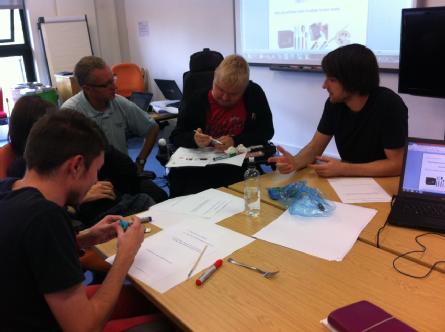 |
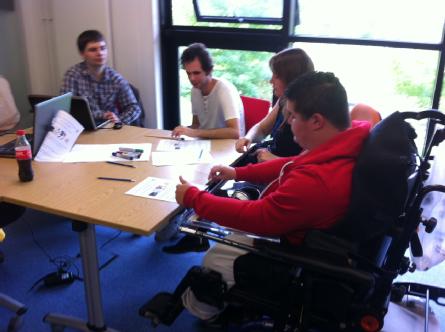 |
| WMG student James Atkinson working with Hereward students |
Staff from Computer Science working with Hereward College students |


























